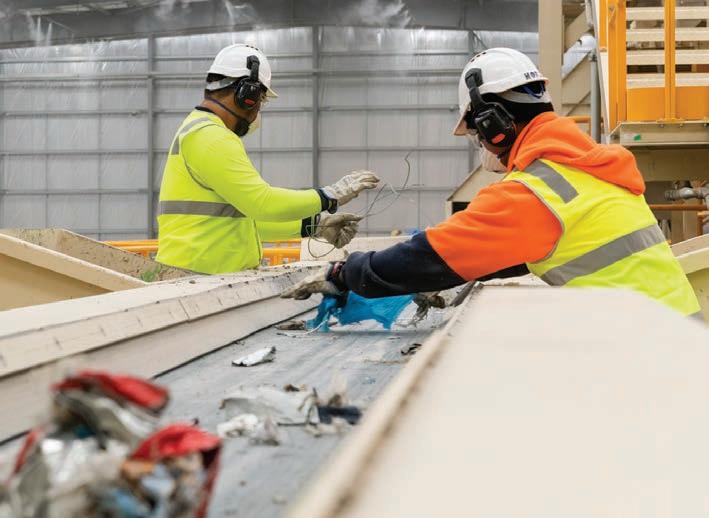
4 minute read
REACHING NET ZERO
RESOURCECO IS LEADING THE WAY TO ENSURE THERE IS A WIDER COMMUNITY BENEFIT TO CARBON ABATEMENT.
Under the Paris Agreement, Australia has a target to reduce the nation’s greenhouse gas emissions by 26 to 28 per cent below 2005 levels by 2030.
To help it reach those goals, the government is turning to technology and, among other things, is investing in large-scale energy storage, improving soil carbon storage and measurement and reducing emissions through carbon capture, use and storage.
Henry Anning, Chief Executive Officer of ResourceCo’s Energy Systems says sustainability and carbon abatement has gained momentum in the past 18 months, evidenced by a significant increase in the cost of carbon credits in that time.
He says that as corporate Australia increases its interest and activity in reaching carbon goals and a net zero future, there is an increasing focus on not just carbon outcomes but circular economy outcomes.
“Companies are seeking carbon credits aligned with their business philosophy,” Henry says. “There is an increasing appetite to put together a portfolio of carbon credits that achieves other outcomes.
“They’re seeking multiple outcomes – social, economic and environmental benefits.”
The Paris Agreement, adopted in 2015 by 196 countries, sets out goals and plans for reduction of emissions of greenhouse gases by each country.
In Australia, the Clean Energy Regulator administers new projects which aim to capture and store carbon or repurpose its emissions. Australian Carbon Credit Units (ACCUs) are a financial instrument awarded to eligible projects which can be purchased by companies to help offset their own emissions. Overseas credits are also available.
The Clean Energy Regulator states that each ACCU represents one tonne of carbon dioxide equivalent stored or avoided by a project.
But, Henry says, not all carbon credits are created equal, and companies are increasingly looking to offset activities and preference ACCUs based on how that carbon is generated.
“Some are having an increasing appetite for Indigenous carbon, that is, carbon generated through projects with Indigenous communities. Others are looking at energy efficiencies or tree planting.
“We’re starting to see that also develop for circular economy carbon – carbon generated from activities in the circular economy which have those other benefits such as reducing landfill and increasing employment.
“Diverting a tonne of waste from landfill and the jobs that come from that are seen as far more tangible.”
ResourceCo is a pioneer in carbon abatement and has been recognised under government schemes since they began 10 years ago. The company has repurposed 60 million tonnes of materials and is one of the largest contributors to carbon abatement in Australia, producing more than two million tonnes of carbon abatement to date – equivalent to taking 450,000 cars off the road.
Henry says ResourceCo is working with major corporations to ensure they understand where their carbon is
ResourceCo has produced more than two million tonnes of carbon abatement.
coming from and the benefits. He says one of the growing areas is from waste generators, keen to get the ACCUs back relating to their waste.
“Everyone generates waste, I can only see there will be more interest and focus on where that waste is going and creating circular economy carbon outcomes for it,” he says.
He points to the Cleanaway ResourceCo Resource Recovery Facility (RRF) in Sydney as an example. The RRF diverts commercial, industrial and demolition waste from landfill to produce process engineered fuel, or PEF, used in cement kilns to replace coal. PEF has a lower emissions profile and displaces millions of tonnes of fossil fuels at a lower price point, as well as abating hundreds of thousands of tonnes of CO2.
“We’re registered under the emissions reduction fund through the alternatives wastes treatment methodology,” Henry says. “We’ve generated ACCUs from that project for a number of years and they achieve significant additional outcomes beyond just carbon.
“These include a 95 per cent diversion from landfill rate, more than 40 full-time jobs and significant ongoing investment, maintenance of materials in the economy rather than just landfilling them and avoiding other environmental impacts of landfill.”
In 2021, as part of its Climate Active Program, the Commonwealth Government ruled that at least 25 per cent of carbon offsets purchased by Australian companies must be ACCUs.
A quick look at the Climate Active Website and it’s noticeable that many carbon abatements are from projects outside of Australia.
Henry agrees price is one factor when companies are purchasing carbon credits. Australian credits are about $30 currently (they were $55) compared to $5 or less from overseas.
“Carbon emissions is a global problem and a tonne of real, verified carbon abatement in China is the same as carbon from Australia – I don’t have a fundamental problem with that,” he says.
“From a perspective point of view, I can see why the government has brought in the minimum use of ACCUs.
“These are Australian products and companies that have gone through strict certification.”
For more information, visit: www.resourceco.com.au











